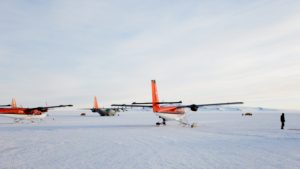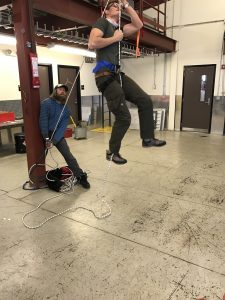We are done, when we are done. See you in about 3 to 5 weeks!




We are done, when we are done. See you in about 3 to 5 weeks!




Here in the Antarctic, unlike at home, we are continuously reminded of the immensity of nature and its ever-present hostility to human life and activity. As we await the “put-in” of our campsite on the Ross Ice Shelf (RIS), each morning we check the TV screens outside the galley (food hall) before breakfast for an update on the day’s scheduled flight from McMurdo to RIS. Each of the last two days, the flight has been cancelled due to weather and/or visibility, effectively pushing our work back a day and gently reminding us of nature’s superiority.
There are many ways to process news of a setback. Hiking and enjoying the raw beauty of McMurdo Sound (and its topography, which our campsite in RIS will distinctly lack over the next three weeks) is one reasonable approach. Computer-based work from inside our offices in the Crary building is another way to spend these unplanned extra days at McMurdo, although the intermittent internet connectivity further tests our patience. One cathartic response to a weather-cancelled flight is to take advantage of the free soft serve “Frosty Boy” ice cream in the galley. When one considers the full context of consuming a cold dessert from inside a large, heated dining hall on an inhospitably cold continent, it’s possible to convince ourselves otherwise of nature’s superiority, at least for a few scoops.

The flight cancellation status screen outside the galley. Adds excitement to breakfast every morning.

Good ol’ Frosty Boy, provider of unlimited soft serve ice cream. Stay tuned for an upcoming post about the “Frosty Boy challenge” which includes creative applications of soft serve ice cream to enhance every meal of the day.

Some quality entertainment options (7 of them!) to keep us occupied while we’re delayed.
P.S. In other news, today we learned from Momme that “pickle” means “ice axe” in German.
Update: No flights for us yet, but we are on weather delay (not cancelled yet!) for a potential flight to take out two stations today. In celebration of the possibility of good news, here’s a picture of a cat Momme used to live with, named Pickle.

Sorry for the delayed posts!…we arrived Thursday last week and have been busy with meetings, training, packing our gear for camp, learning the ins-and-outs of McMurdo town life, and wait, there’s more training! Indoor field safety training and now outdoor training. I have begun to realize that 80% of research in Antartica is preparing and surviving the environment while 20% is direct research…this may not be entirely true but it’s a reality in this harsh environment. This week starts the more intense outdoor training, crevasse training, deep field camp survival, and snowmobile training. Here’s some pictures from the training sessions and a couple of fun pics too.

Tour around McMurdo town

Outdoor crevasse training in the man made crevasse…hard work to get up that wall and fun too!
We’ve safely landed at Pegasus field and are getting settled (and trained) here at McMurdo before heading out to our field camp in a few days. (Note: we’re a few days behind with this post, but stay tuned for more pictures and updates on our last few days of Antarctic activities.)

A stellar first glimpse of sea ice from the luxurious and unexpected B757 flight from Christchurch.

Our royal transport to Antarctica
I’m learning the USAP is well polished machine but this takes it to new levels…royalty! When I heard we might take a commercial style jet instead of the standard cargo planes C17, I was somewhat disappointed for not getting the real experience. Now that I’m on the plane with a window seat, I’m ecstatic!! Now all we have to do is wait and see if we get to take off. There’s always the possibility flights are delayed or even returned before landing, called boomeranging, but hopefully we will get lucky.
Today was our first full day in Christchurch, New Zealand and most of it was spent preparing for our field work in Antarctica. We arrived at the United States Antarctic Research Program station to learn the details of our upcoming trip and get outfitted for the coldest place on earth!

Clothing options at the Clothing Distribution Center

Fully outfitted in polar field gear, Mel Carter is ready to go!

Ready to get there, Laura Stevens is looking for alternate transportation methods.
If all goes well, we will depart tomorrow morning for Antarctica. Keep posted!
We were backup on the Basler today and didn’t fly.
Ever wondered what we do when we don’t fly?
Well, we get up between 5:30 and 6:00. Go and have breakfast to be ready to receive news between 6:45 and 7:00. That’s when they tell us we are staying:
So we have to find some other tasks around the office and there is always something to do!
As non native speaker Zhao and Anja get the chance to learn many colorful englisch sayings:
Hurry up and wait!
When in trouble when in doubt run in circles scream and shout!
You don’t ever know ‘cuz you never can tell!
Can’t get there from here!
…
By then it’s time for lunch.
After lunch we check the news and brows the internet. Lots of patience is needed for this task:
Or we walk over to the library and read books about the first Antarctic explorers like Scott, Shakelton and Amundsen.

The Library is small but has a nice collection with plenty of comfortable couches and nooks to sit and read.
Such a long day. It’s almost time for dinner and to go back to sleep!
Cross your fingers, that we can fly to Yesterday Camp tomorrow morning.
We have a map in our office with all the stations that we have to service.
The weather within the last few days was quite good. So we had the chance to reach some more of our stations by plane. This leaves our group with seven more stations. These stations are close together, within a 20 km radius. On Friday we will go out to a camp they are putting in for us right now and service the last stations from the camp by snowmobile.
Three of the stations we reached last week are about 2 km away from the ice shelf front, offering spectacular views flying there.
A portion of the largest rift on the Ross Ice Shelf seen from the Twin Otter while flying back to McMurdo after servicing station DR15, about 200 km from the shelf front. The rift, a through-going fracture thought to penetrate the entire shelf to the water below, extends for over 100 km roughly parallel to the shelf front, and is over 1 km wide at its widest.
Returning to McMurdo after servicing seismic station DR15, we flew over and along the largest rift on the Ross Ice Shelf. The width of the rift increases towards the center of its length, suggesting the width is increasing there. GPS stations were installed at several stations perpendicular to the shelf front to see if we can detect differential episodic motions across the rifts.
https://www.youtube.com/watch?v=pSGjsHMrMK
We had great views of the Transantarctic Mountains on our way to station DR16.
Luckily no one got sick on the plane so far!